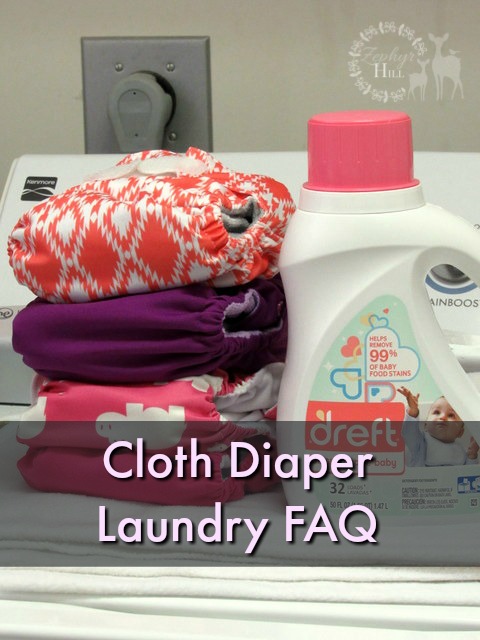
Got questions about cloth diaper laundry? Here are some answers based on my experiences over the past 9 years, and I hope they will be helpful if you’re confused or troubleshooting a particular problem.
Just looking for a basic wash routine? Click here.
How do I prep different types of diapers?
For cotton and hemp, allow two or three washes before first use. The diaper or insert will increase in absorbency after subsequent washes. Organic and unbleached cotton are the exception and may require many more washes. You do NOT have to dry your diapers after every preparatory wash. Drying doesn’t do anything to help prep the fibers, so save energy (and time) by eliminating the multiple dryer cycles. You can also conserve by prepping your diapers along with a load of soiled towels or linens.
Bamboo is a processed rayon fabric and can be used after just one wash. Bamboo blends (with cotton) may require one or two more.
Microfiber, microfleece and suedecloth technically need no prepping at all. Some families wash once to remove any “residue” they worry might be lingering from the factory.
You can find full details on prepping here.
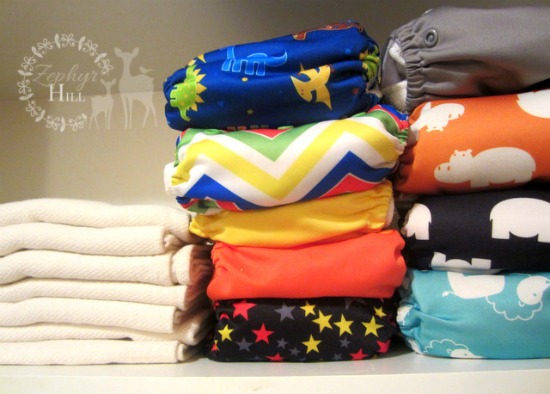
How should I store dirty diapers?
There are many options available to you, so just do whatever works best in your home. Hanging wet bags are completely waterproof, zip shut, and are designed to hang from a sturdy hook or knob. Pail liners have elasticized edges and fit inside traditional diapers pails and some plastic garbage cans. You can choose to use a lid or not. To save money, some families skip the bags and liners altogether and just use a pail or plastic container. The drawback is you have to clean and sanitize it by hand, whereas a wet bag or pail liner can be washed along with your diapers.
You might be worried about diaper odor. Leaving the diaper pail or bag open is actually the best way to cut down on this because air can circulate. However, with toddlers and pets in the house, this is not always a practical option. Spraying your diapers thoroughly before putting in the pail will also help cut down on odors.
Pictured below: Diaper Rite hanging wet bag
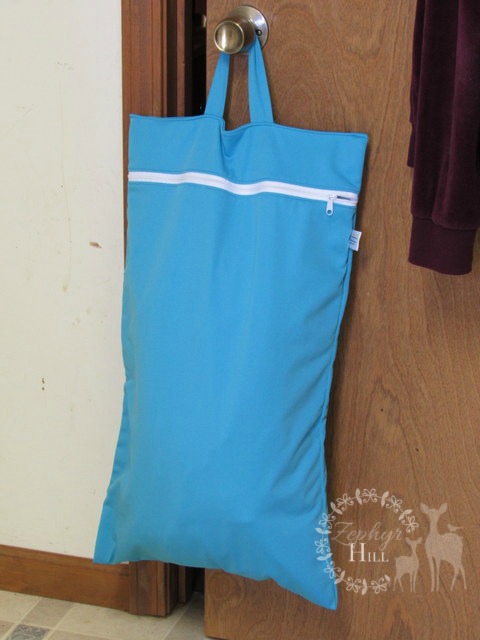
What is a pre-wash and is it needed?
Many families like to do what’s more properly called a “pre-rinse” before actually starting the main, heavy duty wash cycle with detergent. This water-only cycle helps ensure that you aren’t starting the cleaning process in a big poo bath. Check your machine and see what settings are available. On some you can choose rinse only. For models without this setting, choose the quickest wash possible, but don’t add detergent. Why? Because you’d be rinsing your diapers in detergent and poo water, which is a waste of detergent. A rinse is just that – a preparation for deep cleaning.
I’ll give you an example to illustrate this better. When I make homemade grape jelly, I strain the juice through a flour sack towel. When I’m done it’s naturally a deep purple color. I don’t want to just throw that in the wash or it’s going to stain the other fabrics. So I rinse thoroughly in plain water and wring it out before laundering. Now the detergent is ready to do its job, and my wash water is not purple!
So yes, it can be helpful to rinse heavily soiled diapers in plain water first to release most of the poo, and THEN start the main wash with detergent and much cleaner/clearer water.
Should I add extra rinses to my routine?
Your washer already rinses the load at the end of a cycle and that may be all you need. Detergent is already formulated to rinse clean. I see recommendations all the time for one or even two extra rinses after washing cloth diapers, but not everyone’s water and machines are the same.
Don’t add another rinse “just because.” And don’t add a rinse thinking that this alone will solve a stinky diaper problem (the solution is to clean them better!).
Not only can extra rinses waste needless water, but with nearly 80% of Americans having hard water (i.e. high mineral content), additional rinsing can do more harm than good. As I will stress later on, never do anything without a good and logical reason for it.
What is the best detergent for cloth diapers?
There isn’t one. Wish it was that simple! But there’s no one-size-fits-all approach when it comes to which detergent you’ll choose. There are mothers who are 100% happy with their Tide and still others who are 100% happy with their eco-friendly Lulu’s. There’s more to a wash routine than just the detergent, and different factors that must be respected when it comes to our choices (cost, allergies, environmental concerns, etc.). My advice is if you’re new to cloth, then start washing diapers with whatever detergent you are currently happy with right now. If it’s cleaning your toddler’s peed-on sheets and your teenager’s sweaty gym clothes really well, then it’s up to the job of laundering your diapers.
After trying your favorite detergent you feel the diapers aren’t clean enough, try a little more detergent in the main wash, or do some basic troubleshooting. Is your water warm enough? Are you using a long enough cycle with a good balance of water to diapers (for proper agitation)? Have you tested your water to see if it’s excessively hard or soft?
How can I test my water?
This one is easy! You can get a water test strip from Kelly’s Closet for just 60 cents. Add it to your next diaper order. Or, request a free test from Morton Salt.
How does water type effect my laundry routine?
If your water is very hard, it has a pretty high mineral content. Your detergent has to work much harder to clean, so you can do one of three things: (1) add a water softening agent, (2) switch to a specially formulated hard-water detergent, or (3) increase the amount of detergent you use.
If your water is very soft, then you could have the opposite problem – too much detergent. So either decrease the amount slightly, or add an additional rinse to the end of your cycle.
How often should I wash diapers?
Every two or three days is the standard, but some families go a little longer between washes and do just fine. I would recommend against that only if you’re having problems because of it (excessive odor, ammonia build-up, etc.).
How can I minimize the wear and tear that washing inflicts on diapers?
The larger your collection of diapers, the less wash wear they will undergo, so buy as many (used or new) as your budget will allow.
Line drying can help prolong the life of some diapers, but it depends on the fabric. Tiny fibers are lost and collect in the lint filter of your dryer from cotton and other natural fabrics. But there’s not much difference in wear on textiles like PUL and microfiber whether you machine dry or line dry.
Some additives can accelerate diaper wear, too, including bleach, borax and Oxiclean, so do not use them routinely.
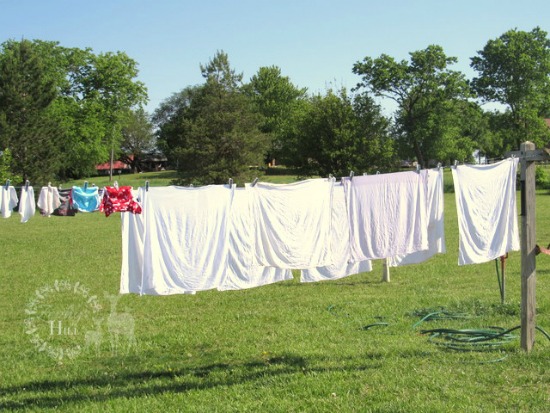
What additives will improve my laundry routine?
My advise is to never add anything to your wash routine just because. You need a logical reason for everything you do. It may sound crazy, but a lot of people whose diapers are already getting clean add “boosters” or additional cleaning agents simply because they think “it can’t hurt.” If you don’t need it, then it’s a waste of money, and could potentially cause more wear and tear.
Before you try anything, nail down the exact problem first.
So to answer the original question, if you have a solid laundry routine, nothing is needed to improve it. Enjoy your clean diapers!
If something isn’t right, check it against this list:
- Diapers don’t smell clean after being laundered: Test your water hardness and then use the recommendations for water type above. If you’re not happy with your washing machine, and are consistently having a hard time getting diapers clean, consider eliminating all synthetics from your stash and switching to all cotton instead. Cotton is so much easier to keep clean and odor-free.
- Diapers reek of ammonia: Rinse them thoroughly before washing, especially if you have a baby or older toddler who wears one diaper all night long. You can also strip your diapers with a product approved specifically for ammonia removal (I like GroVia Mighty Bubbles available at Nicki’s and Diaper Junction). Consider switching to diapers with less layers to clean, like flats, for future prevention. Keep your baby well hydrated for less concentrated diapers.
- Diapers are causing rashes: Strip your diapers. Try switching to a hypo-allergenic detergent if you think the issue is contact rash (dermatitis). See if the problem might be due to irritation from ammonia (above) and troubleshoot as needed. Apply a thin layer of cloth-safe ointment on your baby’s bum at each change. Try stay-dry microfleece liners if you think your baby is hyper-sensitive to wetness.
How do I disinfect cloth diapers?
You might need to get yeast out of diapers. Or want to do a thorough “reset” after a GI bug. Maybe you’re just trying to play it safe with some used diapers that you bought.
The gold standard is bleach, but it must be done properly. If you are worried about bleach ruining your diapers or not rinsing out, check out this Q&A from Clorox. If dealing specifically with yeast, Grapefruit seed extract has been shown to be highly effective in killing spores.
Some recommend oxygen bleach (i.e. Oxiclean) as an alternative, but from what I’ve researched, it is not a comparable substitute for bleach. Nor does Oxiclean makes any claim to the contrary. It is advertised solely as a stain remover, odor remover and laundry “booster.” When mixed with water, Oxiclean releases hydrogen peroxide, which is very weak in comparison to bleach and has only limited antibacterial effects. And hydrogen peroxide does not kill viruses like beach can.
Do not use the sanitize setting on your washer to disinfect diapers (sanitizing and disinfecting are two different things anyway). Higher temperatures can damage the elastic and PUL in your diapers.
Finally, unless you are a professional diaper service, bleach shouldn’t be used routinely, like you would a water softener. Something is lacking in your wash routine if you are adding bleach constantly to get your diapers clean.
How do I get rid of stains?
First, try to keep them at bay with good rinsing, and using cloth diaper liners.
Some fabrics, like microfleece and charcoal bamboo, are really good at resisting and releasing stains. Others, like organic cotton and hemp, stain easily and hang onto discoloration more stubbornly.
When treating an existing stain, my first tool is the Buncha Farmers Stain Stick. Then I launder as usual and hang to dry for hours in the sun.
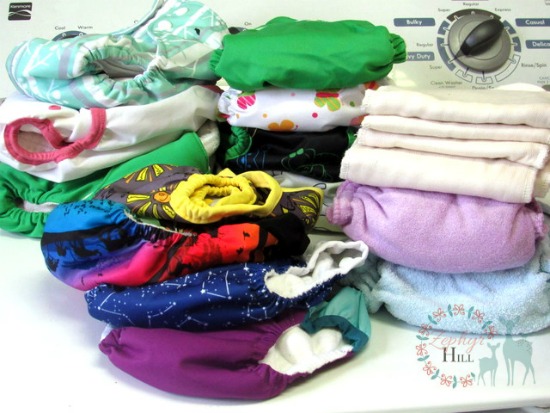
Should I strip my diapers occasionally?
There’s something undeniably appealing about the idea of stripping cloth diapers, isn’t there? Ahhh, to refresh all your diapers and get back to square one!
Interestingly, my friend Maria at Change Diapers blog did a survey and found that 49% of families were stripping their diapers even though their detergent was working fine. But the fact is, stripping is hard on diapers and you should not be doing it on a regular basis, or there’s something wrong with your basic wash routine. Stripping (here’s how) is only needed to address specific problems like repelling, build-up and ammonia.
Any questions or comments?
Leave me a reply below, and let’s keep the conversation going!
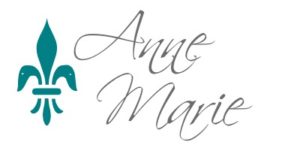
Great post, Anne!
I’ll definitely be passing this one along to my cloth diapering friends and those just getting started!
Many thanks, Kaitlin! ~Anne Marie
I have cloth diapered all 4 of my kids. The youngest is currently in diapers. This is great info. I’ve tried a lot of detergents and found that Charlie’s Soap was the most gentlest for us. My littlest one has super sensitive skin, so I always do 3 rinses to make sure we’ve gotten all the detergent out.
So glad you found something that worked well for your baby! ~Anne Marie
This was really interesting and informative. I wanted to do the cloth diaper thing when my kids were babies!
My mom used a diaper service a million years ago when my brother was a baby, but it’s great that families can do the same pretty easily at home!
This is a really helpful guide. Adding cloth diaper washing into my routine will be easy enough!
When my son was a baby I dabbled in cloth diapers. Wish I would have stuck it out!
I love that cloth is great with sensitive skin. I know I’ll be using cloth diapers again if I ever have another kid.
I had issues with build up after a while, but I also used microfiber. I was a huge fan of Tide.
My SIL uses cloth diapers for her youngest daughter. She does a lot of laundry every week! These are great tips worth sharing.
You answered a lot of my question about of diaper laundry. In the past, I used a lot of additional cleaning agents, but now I know that they are not neccessary.
Thank you so much for these useful tips! I always do pre-rinsing and it really helps to make the diapers cleaner.
Super helpful! My best friend is having her first baby and she’s also getting into cloth diapering, I’ll be sending her this post!
I have a friend who swears by cloth diapers so I will definitely share this information with her. It’s very informative!
I really want to cloth diaper. This is a great resource!
This is such a great resource for cloth-diapering moms. I bet all the older moms are wishing the internet had been around when they were younger!
Super helpful Anne Marie! I fixed a washing problem by adding the water softener (Calgon) with my mainstream detergent!
I just started cloth diapers with my 2 month old and I was curious to see if I was doing a good washing routine, so this was very helpful!
This is quite a primer for cloth diapering and should be a must-read for anyone considering it.